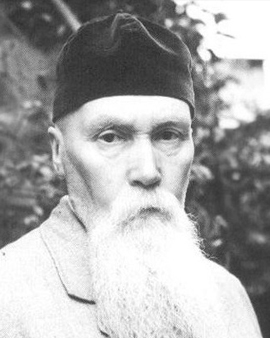Nikolai Konstantinovich Roerich was a Russian painter, scientist, philosopher and archaeologist. He was a very calm person who needed harmony. The sculptor Mikhail Mikeshin, who was a frequent guest of the Roerich family, noticed that Roerich had a talent for drawing and began to teach him the art of craftsmanship. Roerich then began to study at Karl May's grammar school. Among his classmates were famous people like Alexander Benois or Dmitri Filosofov. His first work had already caused a great stir and was acquired by the world-famous collector Tretyakov. Parallel to his art studies he began to study law, but his interest in art was greater. During his studies he had contact to writers like Leo Tolstoy, composers like Stravinsky or world-famous artists like Ilya Repin and Sergei Djagilew. In the following years he was engaged in archaeology and the restoration of ancient Russian monuments. In the process he travelled to old Russian villages and abroad. The three-year expedition to the Himalayas left a lasting impression on the artist. He was not only interested in the region in his role as an artist. His aim was to study and solve the problems of the world migration of ancient peoples.
During this journey Roerich and his wife founded the theosophical association Agni Yoga (Living Ethics). The goal of this association is to create a higher level of human development. In 1929 the artist initiated the Roerich Pact. This was the first document dealing with the protection of the world cultural heritage. The agreement for the protection of art institutions was signed by 21 countries. At that time he was nominated for the Nobel Prize. Roerich died of a heart attack in 1947. The artist was buried according to Indian tradition: his body was cremated and scattered by a high mountain.
Nikolai Konstantinowitsch Roerich created about 7000 paintings, which are in well-known museums. He wrote poetic works, but also philosophical treatises. For many of his contemporaries he was an enigma. His paintings, on the other hand, fascinated with their subtle, cheerful colour, with which he presented the mysterious greatness of nature. Indira Ghandi, the Prime Minister of India from 1966 to 1984, knew the artist personally and appreciated his work. She valued him and his family as a link between the Soviet Union and India. Roerich's art is still relevant in Russia. Russia's President Putin appreciated him as a first step for the Russian-Indian friendship.
×





.jpg)
.jpg)
.jpg)
.jpg)
.jpg)
.jpg)
.jpg)
.jpg)
.jpg)
.jpg)
.jpg)
.jpg)
.jpg)
.jpg)
.jpg)
.jpg)
.jpg)
.jpg)
.jpg)
.jpg)
.jpg)
.jpg)
.jpg)
.jpg)
.jpg)
.jpg)
.jpg)
.jpg)
.jpg)
.jpg)
.jpg)
.jpg)
.jpg)
.jpg)
.jpg)
.jpg)
.jpg)
.jpg)
.jpg)
.jpg)
.jpg)
.jpg)
.jpg)
.jpg)
.jpg)
.jpg)
.jpg)
.jpg)
.jpg)
.jpg)
.jpg)
.jpg)
.jpg)
.jpg)
.jpg)
.jpg)
.jpg)
.jpg)
.jpg)
.jpg)
.jpg)
.jpg)
.jpg)
.jpg)
.jpg)
.jpg)
.jpg)
.jpg)
.jpg)
.jpg)
.jpg)
.jpg)
.jpg)
.jpg)
.jpg)
.jpg)
.jpg)
.jpg)
.jpg)
.jpg)
.jpg)
.jpg)
.jpg)
.jpg)
.jpg)
.jpg)
.jpg)
.jpg)
.jpg)
.jpg)
.jpg)
.jpg)
.jpg)
.jpg)
.jpg)
.jpg)
_-_(MeisterDrucke-689311).jpg)
_-_(MeisterDrucke-689311).jpg)
.jpg)
.jpg)
.jpg)
.jpg)
.jpg)
.jpg)
.jpg)
.jpg)
.jpg)
.jpg)
.jpg)
.jpg)
.jpg)
.jpg)
.jpg)
.jpg)
.jpg)
.jpg)
.jpg)
.jpg)
.jpg)
.jpg)
.jpg)
.jpg)
.jpg)
.jpg)
.jpg)
.jpg)
.jpg)
.jpg)
.jpg)
.jpg)
.jpg)
.jpg)
.jpg)
.jpg)
.jpg)
.jpg)
.jpg)
.jpg)
.jpg)
.jpg)
.jpg)
.jpg)
.jpg)
.jpg)
.jpg)
.jpg)
.jpg)
.jpg)
.jpg)
.jpg)
.jpg)
.jpg)
.jpg)
.jpg)
.jpg)
.jpg)
.jpg)
.jpg)
.jpg)
.jpg)
.jpg)
.jpg)
.jpg)
.jpg)
.jpg)
.jpg)
.jpg)
.jpg)
.jpg)
.jpg)
.jpg)
.jpg)
.jpg)
.jpg)
.jpg)
.jpg)
.jpg)
.jpg)
.jpg)
.jpg)
.jpg)
.jpg)
.jpg)
.jpg)
.jpg)
.jpg)
.jpg)
.jpg)
.jpg)
.jpg)
.jpg)
.jpg)
.jpg)
.jpg)
.jpg)
.jpg)
.jpg)
.jpg)
.jpg)
.jpg)




